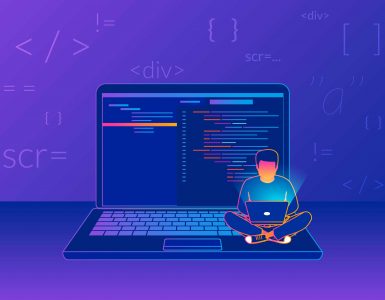Web development falls into two broad categories: frontend and backend. Frontends interact with users, and backends handle internal functions. A frontend may or may not work without a backend. But to create a fully functional web application, it’s essential to have an ultra-responsive frontend connected with a powerful backend framework. Simply put, building world-class mobile apps requires trustworthy frameworks on both ends. This not only simplifies the programming process, but also speeds up development. But how to find the most suitable one? Which one actually matters? Front end or backend. There are countless mobile app development frameworks in the market that are both popular and powerful. Where do I start?
A list of the 10 best backend frameworks for mobile app development should be the best place to start. For frontend, you can check our blog post for essential tools for faster frontend development. In this blog, we will not only cover and explore what backend development is and what the top backend frameworks are, but also how these frameworks would impact your mobile app development project.
What is a mobile app backend?
The mobile app backend framework is the backbone of your app and lives on the server. It helps create and manage all essential services in the background function of a mobile or web app. A database, web server, operating system, framework, and server-side languages such as Python, PHP,.Net, Swift, Objective-C, JavaScript, Ruby, Kotlin, C#, C++, GO, and Dart are examples of back-end components.
Best Mobile App Backend Framework in 2022-23
According to Statista, smartphone users are expected to reach 7.5 billion by 2026.
Following these expectations, mobile app development has become one of the most profitable business opportunities in recent years. Many developers are seeking the best framework to build their mobile apps, due to the growing demand for them. To address their challenges, in this section we will discuss the most popular framework for mobile backend development, and how it can help you build apps with its amazing features and functionalities.
Here is the list of the best mobile app backend frameworks for 2022–2023.
1.NodeJS
NodeJS is the most popular backend framework for mobile app development. It is a cross-platform, server-side JavaScript environment that can be used to build scalable and high-performance web applications. It has an extensive collection of modules that can be used to build applications, and it’s also fast, scalable, and lightweight.
NodeJS was created by Ryan Dahl and TJ Holowaychuk, who were looking for a way to create their own server-side scripting language. With Node JS, developers are able to write JavaScript on both the client and server sides. In real-time applications, this enables data transfer between the server and the client, thereby enabling synchronisation.
Features of NodeJS include:
- Suitable for cross platform mobile applications development
- Easier development process
- Code reusability and code sharing
- Backed by leading companies 2.1% of all websites
- Asynchronous handling of requests
- The availability of free tools
2. Express JS
Express JS is a lightweight framework for building web applications. It is built on top of Node.js and uses the CommonJS module system, which makes it easy to use in any JavaScript project. It also has lots of features, such as routing, validation, tagging, and more, that make it a good choice for building RESTful APIs.
In addition to its many useful features, Express JS has also been gaining popularity since its inception, by John McCrate as part of his course at Front End Masters (now Creative Coding).
Features of Express js
- Server-side development that is faster Features for developing web and mobile applications
- A layer built on top of Node js helps managing servers and routes.
- It enables developers to create APIs and web applications with ease
- Makes it easier to identifies bug areas
3. React Native
Known as an open-source, cross-platform app development framework, React Native was introduced by Facebook in 2018. It has been developed and maintained by the tech giant since its release. In addition, React Native simplifies iOS and Android app development, which plays a significant role in its popularity. There are a number of popular applications based on the React Native framework, such as Amazon Prime, Tesla, Skype, Airbnb, and so on.
Features of React Native include:
- Compatibility with third-party plugins
- Reusable components
- Superior performance
- It supports both iOS and Android.
4. Flutter
Flutter is an open-source framework developed by Google for creating cross-platform applications using one codebase. With its innovative design strategy for designing applications that have a native-like appearance and feel, this SDK is an excellent tool for building cross-platform applications. It is often the best choice for mobile app developers to create an engaging application with a highly reliable mobile user interface quickly.
The Flutter framework offers widgets, a rendering engine, testing, and a number of other tools to let programmers create and develop visually appealing mobile apps. Flutter technology is used by reputable companies, such as Alibaba, Google, and Abby Road Studios.
Features of the Flutter framework:
- powerful widget support
- Streamlining the development process
- highly reliable mobile user interface
- in-built material design
- Rich motion APIs
- high-performance app similar to native
5. Laravel
Laravel is definitely one of the most popular PHP frameworks to use and is ideal for all types of applications, especially custom requirements such as portal mobile apps, social media apps, It offers predefined templates that enable a quick and time-saving mobile app development process. For mobile developers, it creates a simpler backend development process, which makes it easy to meet the feature requirements of the user.
Though Laravel isn’t the only PHP framework, if you have already used it, you might use other popular PHP frameworks like CodeIgniter, CakePHP, or Zend Frameworks.
It includes the following features:
- Simpler backend development
- OPen-source framework
- Quick and easy to market
- Enhanced security
- Community support
6. .NET MAUI (formerly known as Xamarin)
Xamarin has been a leading open-source, cross-platform application platform for the development of high-performance mobile apps for iOS, Android, and Windows since its introduction in 2011. The platform was deprecated in November 2021. It was eventually replaced by.NET MAUI (.NET Multi-Platform App UI), which is used by businesses across industries to create scalable and performant cross-platform Android and iOS apps.
“As per the survey, more than 15,000 organizations and 1.4 million programmers were using Xamarin.” The framework’s apps have an average market share of 1.88%, with business-related apps having the highest market share at 6.54%.
The stats only highlight the popularity of Xamarin; developers can try out the new.NET MAUI to stay updated with its new versions.
7. Loopback
Loopback is a Node.js framework for creating APIs. It has an ORM, a CLI, and a REST API generator that generates all of the code you need to create your app’s APIs.
Loopback was originally created by the team behind Express and can be used with any database, so it’s easy to integrate into your existing projects if you have one (like MySQL). The core of Loopback is built on Express, but it includes more than just this framework; it also includes other useful modules such as form validation and authentication integration, making Loopback incredibly flexible when it comes to building apps in addition to APIs!
- Makes it easy to handle data in a persistence system
- Designed to create APIs and connecting them with backend data sources
- TCP loopback optimization to a low-latency loopback path for performance-critical applications
- Availability of offline data access and synchronization
8. Django
Developed in Python, Django is a free, open-source framework based on a model-view-template architecture. Django is designed by experienced developers to develop better web apps more quickly and with fewer lines of code. As well as taking away much of the hassle of web development, so you can focus on writing your app rather than reinventing the wheel.
It is maintained by the Django Software Foundation (DSF), an independent organisation established to advance the Django software and its community.
Django offers features such as:
- Exceptionally scalable
- Designed to drive faster, clean and pragmatic development cycles
- Advance the state of the art in Web development.
- Protect the intellectual property and the framework’s long-term viability.
9. Ruby on Rails
A model-view-controller framework, Ruby on Rails is a Ruby-based open-source framework for developing web applications. This means that it separates your application into three main parts: models (representing data), views (displaying that data), and controllers (controlling the flow of your application).
Rails has become extremely popular because of its ease of use and flexibility. It allows developers to quickly build complex applications with minimal overhead, making them ideal when you need something fast but still want something robust enough to handle larger loads or more complex needs.
Features of Ruby on Rails include:
- Allow easy changes in codes for
- Extremely scure server side web application
- Database-backed web applications according to MVC pattern
- Clean and easy to learn syntax for developers
- More organized and Object oriented
10. Spring Boot
Spring Boot is a microservices framework that takes care of most of the boilerplate work for you. It’s designed to help you build fast, production-ready applications using only the features you need and none of the ones you don’t.
Spring Boot provides an opinionated set of features out of the box:
- a Maven repository with many pre-packaged dependencies, including spring-boot-starter, springfox, and orocrudus (more on these later).
- a simple configuration file that defines all your application’s dependencies, startup classes, and service definitions in one place.
This makes it easy for developers who already know how to use a tool like Gradle or Maven but haven’t had much experience with Java yet, because they’re not required to learn anything new!
 Conclusion
Conclusion
Choosing the right mobile app backend framework isn’t always easy, so we’ve put together this handy guide on what makes for great software development tools for developers working on your next project!
This post describes the top mobile app backend development frameworks that help you build apps with amazing features and functionalities. However, it’s important to realise that there are many good choices for building a mobile app backend. You can use one of the frameworks listed above, or you can create your own custom one. If you’re new to developing apps, this article will help you decide which framework is best for your project’s needs.






Add comment